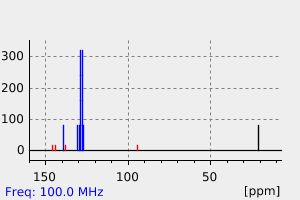2-碘-5-甲基-1,1'-联苯 | 1214389-60-2
中文名称
2-碘-5-甲基-1,1'-联苯
中文别名
——
英文名称
2-iodo-5-methyl-1,1'-biphenyl
英文别名
5-methyl-2-iodobiphenyl;2-iodo-5-methylbiphenyl;2-iodo-5-methyl-1,1′-biphenyl;1-Iodo-4-methyl-2-phenylbenzene
CAS
1214389-60-2
化学式
C13H11I
mdl
——
分子量
294.135
InChiKey
AUYSXQQNEPJDOE-UHFFFAOYSA-N
BEILSTEIN
——
EINECS
——
-
物化性质
-
计算性质
-
ADMET
-
安全信息
-
SDS
-
制备方法与用途
-
上下游信息
-
文献信息
-
表征谱图
-
同类化合物
-
相关功能分类
-
相关结构分类
物化性质
-
沸点:335.4±21.0 °C(Predicted)
-
密度:1.523±0.06 g/cm3(Predicted)
计算性质
-
辛醇/水分配系数(LogP):4.6
-
重原子数:14
-
可旋转键数:1
-
环数:2.0
-
sp3杂化的碳原子比例:0.08
-
拓扑面积:0
-
氢给体数:0
-
氢受体数:0
反应信息
-
作为反应物:描述:2-碘-5-甲基-1,1'-联苯 在 1,2,3,4,5,6,7,8-八硫杂环辛烷 、 copper(l) iodide 、 sodiumsulfide nonahydrate 作用下, 以 N,N-二甲基甲酰胺 为溶剂, 以94%的产率得到bis(2-phenyl-4-methylphenyl) disulfide参考文献:名称:卤素介体通过分子内 C-S 环化电化学合成二苯并噻吩摘要:实现了二苯并噻吩衍生物的电化学合成。几种双(联芳基)二硫化物通过电化学氧化有效转化为二苯并噻吩。使用 Bu 4 NBr 作为卤素介体是必要的,并且以良好的产率获得了多种二苯并噻吩衍生物。DOI:10.1021/acs.orglett.2c03574
-
作为产物:描述:5-甲基-2-联苯胺 在 盐酸 、 sodium nitrite 、 potassium iodide 作用下, 以 水 为溶剂, 反应 3.0h, 以94%的产率得到2-碘-5-甲基-1,1'-联苯参考文献:名称:通过 1,1-二氟-1-烯烃的多米诺环化合成甲基芳烃基多环芳烃摘要:通过基于甲基芳烃的协议合成了含有 4-7 个苯环的多环芳烃 (PAH)。三甲基[2-(三氟甲基)烯丙基]硅烷经亲电苄化...DOI:10.1246/bcsj.20190252
文献信息
-
Rapid Formation of Fluoren-9-ones via Palladium-Catalyzed External Carbon Monoxide-Free Carbonylation作者:Hideyuki Konishi、Suguru Futamata、Xi Wang、Kei ManabeDOI:10.1002/adsc.201800155日期:2018.5.2carbonylation reaction for the synthesis of fluoren‐9‐ones from 2‐halogenated biphenyls using phenyl formate as a carbon monoxide surrogate was achieved. The combined use of cesium carbonate and o‐anisic acid resulted in a remarkable rate enhancement, where the reaction was complete within 3 min in some cases. Mechanistic studies indicated that the turnover‐limiting step of the reaction was the C−H bond‐cleaving
-
Palladium-Catalyzed C−H Silylation through Palladacycles Generated from Aryl Halides作者:Ailan Lu、Xiaoming Ji、Bo Zhou、Zhuo Wu、Yanghui ZhangDOI:10.1002/anie.201800330日期:2018.3.12A highly efficient palladium‐catalyzed disilylation reaction of aryl halides through C−H activation has been developed for the first time. The reaction has broad substrate scope. A variety of aryl halides can be disilylated by three types of C−H activation, including C(sp2)−H, C(sp3)−H, and remote C−H activation. In particular, the reactions are also unusually efficient. The yields are essentially
-
Synthesis of Fluorenes Starting from 2-Iodobiphenyls and CH<sub>2</sub>Br<sub>2</sub> through Palladium-Catalyzed Dual C–C Bond Formation作者:Guangfa Shi、Dushen Chen、Hang Jiang、Yu Zhang、Yanghui ZhangDOI:10.1021/acs.orglett.6b01300日期:2016.6.17for the synthesis of fluorene and its derivatives starting from 2-iodobiphenyls and CH2Br2. A range of fluorene derivatives can be synthesized under relatively mild conditions. The reaction proceeds via a tandem palladium-catalyzed dual C–C bond formation sequence through the key dibenzopalladacyclopentadiene intermediates, which are obtained from 2-iodobiphenyls through palladium-catalyzed C–H activation
-
Palladium-catalyzed coupling reaction of 2-iodobiphenyls with alkenyl bromides for the construction of 9-(diorganomethylidene)fluorenes作者:Ya-Heng Zhao、Jian-Long Wang、Yun-Bing Zhou、Miao-Chang Liu、Hua-Yue WuDOI:10.1039/d1ob01547h日期:——protocol for the construction of 9-(diorganomethylidene)fluorenes through palladium-catalyzed coupling reactions of 2-iodobiphenyls with alkenyl bromides has been reported. The reaction proceeds through the C–H activation/oxidative addition/reduction elimination/intramolecular Heck coupling reaction to afford a series of 9-(diorganomethylidene)fluorenes with good yields. Control experiments demonstrate that
-
α-Bromoacrylic Acids as C1 Insertion Units for Palladium-Catalyzed Decarboxylative Synthesis of Diverse Dibenzofulvenes作者:Minghao Zhang、Wenbo Deng、Mingjie Sun、Liwei Zhou、Guobo Deng、Yun Liang、Yuan YangDOI:10.1021/acs.orglett.1c01888日期:2021.8.6Herein α-bromoacrylic acids have been employed as C1 insertion units to achieve the palladium-catalyzed [4 + 1] annulation of 2-iodobiphenyls, which provides an efficient platform for the construction of diverse dibenzofulvenes. This protocol enables the formation of double C(aryl)–C(vinyl) bonds via a C(vinyl)–Br bond cleavage and decarboxylation. It is particularly noteworthy that the method features
表征谱图
-
氢谱1HNMR
-
质谱MS
-
碳谱13CNMR
-
红外IR
-
拉曼Raman
-
峰位数据
-
峰位匹配
-
表征信息
同类化合物
(βS)-β-氨基-4-(4-羟基苯氧基)-3,5-二碘苯甲丙醇
(S,S)-邻甲苯基-DIPAMP
(S)-(-)-7'-〔4(S)-(苄基)恶唑-2-基]-7-二(3,5-二-叔丁基苯基)膦基-2,2',3,3'-四氢-1,1-螺二氢茚
(S)-盐酸沙丁胺醇
(S)-3-(叔丁基)-4-(2,6-二甲氧基苯基)-2,3-二氢苯并[d][1,3]氧磷杂环戊二烯
(S)-2,2'-双[双(3,5-三氟甲基苯基)膦基]-4,4',6,6'-四甲氧基联苯
(S)-1-[3,5-双(三氟甲基)苯基]-3-[1-(二甲基氨基)-3-甲基丁烷-2-基]硫脲
(R)富马酸托特罗定
(R)-(-)-盐酸尼古地平
(R)-(-)-4,12-双(二苯基膦基)[2.2]对环芳烷(1,5环辛二烯)铑(I)四氟硼酸盐
(R)-(+)-7-双(3,5-二叔丁基苯基)膦基7''-[((6-甲基吡啶-2-基甲基)氨基]-2,2'',3,3''-四氢-1,1''-螺双茚满
(R)-(+)-7-双(3,5-二叔丁基苯基)膦基7''-[(4-叔丁基吡啶-2-基甲基)氨基]-2,2'',3,3''-四氢-1,1''-螺双茚满
(R)-(+)-7-双(3,5-二叔丁基苯基)膦基7''-[(3-甲基吡啶-2-基甲基)氨基]-2,2'',3,3''-四氢-1,1''-螺双茚满
(R)-(+)-4,7-双(3,5-二-叔丁基苯基)膦基-7“-[(吡啶-2-基甲基)氨基]-2,2”,3,3'-四氢1,1'-螺二茚满
(R)-3-(叔丁基)-4-(2,6-二苯氧基苯基)-2,3-二氢苯并[d][1,3]氧杂磷杂环戊烯
(R)-2-[((二苯基膦基)甲基]吡咯烷
(R)-1-[3,5-双(三氟甲基)苯基]-3-[1-(二甲基氨基)-3-甲基丁烷-2-基]硫脲
(N-(4-甲氧基苯基)-N-甲基-3-(1-哌啶基)丙-2-烯酰胺)
(5-溴-2-羟基苯基)-4-氯苯甲酮
(5-溴-2-氯苯基)(4-羟基苯基)甲酮
(5-氧代-3-苯基-2,5-二氢-1,2,3,4-oxatriazol-3-鎓)
(4S,5R)-4-甲基-5-苯基-1,2,3-氧代噻唑烷-2,2-二氧化物-3-羧酸叔丁酯
(4S,4''S)-2,2''-亚环戊基双[4,5-二氢-4-(苯甲基)恶唑]
(4-溴苯基)-[2-氟-4-[6-[甲基(丙-2-烯基)氨基]己氧基]苯基]甲酮
(4-丁氧基苯甲基)三苯基溴化磷
(3aR,8aR)-(-)-4,4,8,8-四(3,5-二甲基苯基)四氢-2,2-二甲基-6-苯基-1,3-二氧戊环[4,5-e]二恶唑磷
(3aR,6aS)-5-氧代六氢环戊基[c]吡咯-2(1H)-羧酸酯
(2Z)-3-[[(4-氯苯基)氨基]-2-氰基丙烯酸乙酯
(2S,3S,5S)-5-(叔丁氧基甲酰氨基)-2-(N-5-噻唑基-甲氧羰基)氨基-1,6-二苯基-3-羟基己烷
(2S,2''S,3S,3''S)-3,3''-二叔丁基-4,4''-双(2,6-二甲氧基苯基)-2,2'',3,3''-四氢-2,2''-联苯并[d][1,3]氧杂磷杂戊环
(2S)-(-)-2-{[[[[3,5-双(氟代甲基)苯基]氨基]硫代甲基]氨基}-N-(二苯基甲基)-N,3,3-三甲基丁酰胺
(2S)-2-[[[[[((1S,2S)-2-氨基环己基]氨基]硫代甲基]氨基]-N-(二苯甲基)-N,3,3-三甲基丁酰胺
(2S)-2-[[[[[[((1R,2R)-2-氨基环己基]氨基]硫代甲基]氨基]-N-(二苯甲基)-N,3,3-三甲基丁酰胺
(2-硝基苯基)磷酸三酰胺
(2,6-二氯苯基)乙酰氯
(2,3-二甲氧基-5-甲基苯基)硼酸
(1S,2S,3S,5S)-5-叠氮基-3-(苯基甲氧基)-2-[(苯基甲氧基)甲基]环戊醇
(1S,2S,3R,5R)-2-(苄氧基)甲基-6-氧杂双环[3.1.0]己-3-醇
(1-(4-氟苯基)环丙基)甲胺盐酸盐
(1-(3-溴苯基)环丁基)甲胺盐酸盐
(1-(2-氯苯基)环丁基)甲胺盐酸盐
(1-(2-氟苯基)环丙基)甲胺盐酸盐
(1-(2,6-二氟苯基)环丙基)甲胺盐酸盐
(-)-去甲基西布曲明
龙蒿油
龙胆酸钠
龙胆酸叔丁酯
龙胆酸
龙胆紫-d6
龙胆紫







